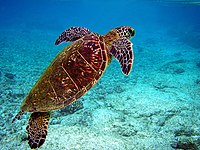
Photo from wikipedia
Introduction Green sea turtles are endangered marine reptiles. Carapacial ulcers will develop on juvenile green sea turtles during artificial rescue, seriously affecting their health and potentially leading to death. Methods… Click to show full abstract
Introduction Green sea turtles are endangered marine reptiles. Carapacial ulcers will develop on juvenile green sea turtles during artificial rescue, seriously affecting their health and potentially leading to death. Methods To determine the pathogens causing ulcerative carapacial disease, we performed 16S and ITS high-throughput sequencing, and microbial diversity analysis on samples from carapacial ulcers, healthy carapaces, feces, and seawater of juvenile green sea turtles. Results Our analysis showed that changes in microbial diversity of green sea turtle feces and seawater were not significantly associated with ulcerative carapacial disease. Discussion Psychrobacter sp. is the dominant species in the carapacial ulcers of green sea turtles. The bacterium is present in both healthy turtles and seawater where carapacial ulcers did not occur and decreasing seawater temperatures are likely responsible for the infection of juvenile green turtles with Psychrobacter sp. This is the first study on carapacial ulcers in captive juvenile green sea turtles. Our research provides theoretical guidance for the prevention and control of carapacial ulcers in captive juvenile green sea turtles.
Journal Title: Frontiers in Veterinary Science
Year Published: 2022
Link to full text (if available)
Share on Social Media: Sign Up to like & get
recommendations!